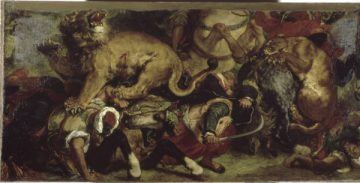Jennifer Olmsted at nonsite:

Delacroix Eugène (1798-1863)
Bordeaux, musée des Beaux-Arts
The sheer oddness of Delacroix’s subject choice and the venue for which his painting was produced suggest that there was more at stake here than the simple reenactment of a cherished theme. Barthélémy Jobert has stressed the Exposition’s significance for the artist, calling it “the final turning point in Delacroix’s career—and one of the most important stages, when he was finally acknowledged by every authority.”10 In Jobert’s estimation, Delacroix’s participation in the Exposition resulted in his election, after seven previous rejections, to the Institut de France. The Exposition was unquestionably a moment of high visibility for Delacroix, both as an artist and as an administrator (the latter thanks to his appointment to the organizing committee). While he cannot have known what impact the Exposition would have on his career, Delacroix understood its importance as a showcase for contemporary art, and he persuaded the committee that the Exposition should focus on the work of living artists rather than serving as a retrospective of nineteenth-century art.11Given this context, it seems likely that the decision to depict a lion hunt was made carefully. Delacroix received his official appointment to the organizing committee on 24 December 1853, and the commission for the painting followed on 24 March 1854.
more here.
